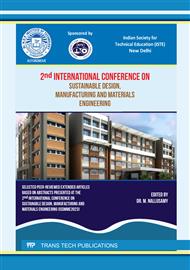[1]
Avinash Juriani, Casting Defects Analysis in Foundry and Their Remedial Measures with Industrial Case Studies, IOSR Journal of Mechanical and Civil Engineering, 12 (2015) 43–54.
Google Scholar
[2]
Wasim Ahmad, Anil Verma, Priyanka Jhavar, A review on casting defect reduction in a foundry shop using the DMAIC technique, International Journal of Advance Research, Ideas, and Innovations in Technology, 5 (2019) 1449-1459.
Google Scholar
[3]
Patil Sachi. P and Naik Girish. R, Defect minimization in casting through process improvement: a literature review, IOSR Journal of Mechanical and Civil Engineering, 14 (2017) 9–13.
DOI: 10.9790/1684-1402010913
Google Scholar
[4]
Anil B. Ghubade and Anil Kumar, Review on casting defects and methodologies for quality improvement, Journal of Emerging Technologies and Innovative Research, 6 (2019) 1008–1019.
Google Scholar
[5]
Chandrashekhar. L, Dilip R, Karthik R, Manoj Kumar B.G, Sufiyan Ahmed Khan, Automated Capsicum Segregation Machine, Journal of Critical Reviews, 7 (2020) 3730-3735.
Google Scholar
[6]
Chelladurai. C, Mohan NS, Hariharashayee D, Manikandan S, and Sivaperumal P, Analysing the casting defects in the small-scale casting industry, Materials Today, 37 (2021) 386-394.
DOI: 10.1016/j.matpr.2020.05.382
Google Scholar
[7]
Kamble Snehal A and Rayjadhav Suyog B, Review Paper on Characterization of Casting Material by Ultrasonic Techniques, International Journal for Innovative Research in Science and Technology, 5 (2019) 21-24.
Google Scholar
[8]
Desai PP, Jadhav Sohan, Lohar Vishal, Kamble Rajat, Gowdham Prasad, and Katwal Amol, Use of Casting Simulation for Yield Improvement, International Research Journal of Engineering and Technology, 6 (2019) 7704-7707.
Google Scholar
[9]
Bahubali B. Kabnure, Vasudev D. Shinde, and Deepak C. Patil, Quality and yield improvement of ductile iron casting by simulation technique, Materials Today, 27 (2020) 111-116.
DOI: 10.1016/j.matpr.2019.09.022
Google Scholar
[10]
Khan MAA and Sheikh AK, Mechanical characterization and quality of iron castings using optimised mould design: simulations and experimental validation, The International Journal of Advanced Manufacturing Technology, 98 (2018) 799-809.
DOI: 10.1007/s00170-018-2325-y
Google Scholar
[11]
Haiping Cao and Magnus Wessén, Mechanisms of segregation band defect formation in pressure diecast magnesium components, Materials Science Forum, 488–489 (2005) 381- 384.
Google Scholar
[12]
Rahul T Patil, Veena S Metri, and Shubhangi Tambore, Causes of Casting Defects with Remedies, International Journal of Engineering Research and Technology, 4 (2015) 639-644.
DOI: 10.17577/ijertv4is110511
Google Scholar
[13]
Vivek S. Gondkar and Inamdar KH, Optimisation of Casting Process Parameters through Simulation, International Journal of Engineering Development and Research, 2 (2014) 2331-2338.
Google Scholar
[14]
Hari Manthran KM, Ganesh Kumar M, and Ravindhan K, Automatic Object sorter: Fabrication of Metal Sorting Out Machine, International Journal of Advance Research and Innovative Ideas in Education, 4 (2018) 1294–1299.
Google Scholar
[15]
Olawale James Okegbile, Nicholas Akhaze Musa, and Samuel Kolo Zhiri, Design and Fabrication of a Solid Waste Sorting Machine, ABUAD Journal of Engineering Research and Development, 1 (2018) 218-224.
Google Scholar
[16]
Choudhary A and Abidi AB, PLC-based Sorting System Using Metal Detection, International Research Journal of Engineering and Technology, 7 (2020) 6350-6355.
Google Scholar
[17]
Hirendra Kumar Verma, Sakshi Dewangan, Praveen Kumar Thakur, Dharmendra Sahu, and Rinkey Sahu, Fabrication of Automated Conveyor Systems for Material Handling Based on LDR, International Journal of Mechanical and Production Engineering, 5 (2017), 10-15.
Google Scholar
[18]
Abhijit Gaikwad, Yogesh Raut, Jitendra Desale, Akshay Palhe, Govinda Shelar, and Shreeekant Pawar, Design and Development of Automated Conveyor System for Material Handling, International Journal of Advance Research, Ideas, and Innovations in Technology, (2017) 31-34.
Google Scholar
[19]
Manoj M. Nehete and Uday C. Patil, Design and Fabrication of a PLC-Based Conveyor System with Programmable Station, International Journal of Analytical, Experimental, and Finite Element Analysis 3 (2017) 53-58.
DOI: 10.26706/ijaefea.3.4.20170906
Google Scholar
[20]
Xintao Zhu, Fu Wang, Dexin Ma, and Andreas Bührig-Polaczek, Dimensional Tolerance of Casting in the Bridgman Furnace Based on 3D Printing Techniques, MDPI, 10 (2020) 1- 23.
DOI: 10.3390/met10030299
Google Scholar



